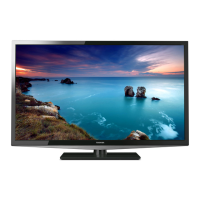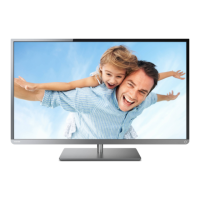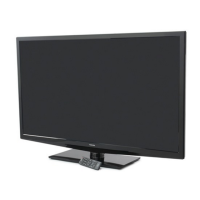How to remove black box on Toshiba 50L4300U LED TV screen?
- AAdam StewartSep 9, 2025
To remove a black box on your Toshiba LED TV screen, set the closed caption feature to Off.

How to remove black box on Toshiba 50L4300U LED TV screen?
To remove a black box on your Toshiba LED TV screen, set the closed caption feature to Off.
How to resolve HDMI™ CEC operation issues on Toshiba 50L4300U LED TV?
To resolve HDMI™ CEC operation issues on your Toshiba LED TV, turn off the TV and unplug the power cord. After about a minute, plug the power cord back in and turn on the TV. You can also try using a different HDMI™ cable.
Why can't I view external signals on my Toshiba LED TV?
To view external signals on your Toshiba LED TV, ensure that the Input Lock is set to Off.
How to improve poor composite picture on Toshiba 50L4300U LED TV?
| Display diagonal | 50 \ |
|---|---|
| LED backlighting type | - |
| Supported video modes | 1080p |
| Display diagonal (metric) | 125.7 cm |
| Screen format adjustments | 16:9 |
| Supported graphics resolutions | 1920 x 1080 (HD 1080) |
| 3D | No |
| Audio system | Audyssey |
| HDMI ports quantity | 4 |
| DVI-D ports quantity | 0 |
| USB 2.0 ports quantity | 2 |
| Compatible memory cards | Not supported |
| Component video (YPbPr/YCbCr) in | 1 |
| Smart modes | Dynamic, Game |
| Lifestyle apps | Skype |
| Product color | Black |
| Panel mounting interface | 400 x 400 mm |
| Power consumption (standby) | - W |
| Sustainability certificates | ENERGY STAR |
| Package depth | 170 mm |
| Package width | 1207 mm |
| Package height | 767 mm |
| Package weight | 21900 g |
| Depth (with stand) | 239 mm |
|---|---|
| Height (with stand) | 744 mm |
| Weight (with stand) | 17400 g |
| Depth (without stand) | 89 mm |
| Width (without stand) | 1138 mm |
| Height (without stand) | 668 mm |
| Weight (without stand) | 15300 g |
Explanation of safety caution icons used in the manual to highlight potential hazards.
Highlights the key technological features and capabilities of the TV.
Guidance on the initial steps for setting up and using the television.
Details on the controls and connections located on the front, side, and back panels of the TV.
Details on various cable connectors and their uses for connecting external devices.
Instructions for connecting various video sources like antennas, cable boxes, DVD players, and computers.
Steps to connect external audio systems, including digital audio and HDMI audio.
Setting up the TV to connect to a home network for Internet access and media sharing.
Using HDMI CEC Control to manage connected devices with the TV remote.
Step-by-step guide on how to install batteries in the remote control.
Information on the optimal distance and angle for remote control operation.
Overview and function of each button on the TV remote control.
Overview of the initial setup steps when turning on or resetting the TV.
Guide through the quick setup wizard, covering essential TV configuration settings.
Instructions on how to access and navigate through the TV's on-screen menu system.
Accessing frequently used options quickly via the Quick Menu.
How to navigate the TV menu and perform the initial setup process.
Configuring country, time zone, daylight saving, store/home mode, and ANT/CABLE input.
Managing TV channels through auto tuning, manual tuning, and skipping channels.
Skipping video inputs and labeling analog TV channels for easier identification.
Settings for configuring shared PC Audio input options.
Instructions for tuning to channels, including auto and manual tuning.
How to select and switch between different video input sources on the TV.
Enabling and customizing closed caption display for analog and digital channels.
Setting, entering, changing, deleting, and recovering PIN codes for menu access.
Using V-Chip and rating limits to block TV programs and movies.
Managing channel locks, unlocking programs, and displaying ratings information.
Locking video inputs and setting a time limit for playing video games.
Using HDMI CEC for device control and locking the TV's control panel.
Options for adjusting the TV screen's aspect ratio and display format, including Native, Full, and TheaterWide modes.
How to adjust picture position for hidden edges and use Auto Aspect and 4:3 Stretch features.
Choosing from predefined picture modes like AutoView, Dynamic, Standard, Movie, Game, and PC.
Fine-tuning picture settings such as brightness, contrast, color, tint, and sharpness.
Using features like Edge Enhancer, Dynamic Contrast, DynaLight, and noise reduction.
Adjusting color temperature, ambient light sensor, base colors, and expert picture settings.
Controlling sound volume, balance, range, stereo/SAP, primary audio language, and speaker output.
Configuring optical audio output format, audio delay, and Dolby Digital Dynamic Range Control.
Utilizing Audyssey technologies for enhanced sound, including EQ, Dynamic Volume, and ABX.
Connecting the TV to a home network, configuring settings, and troubleshooting network issues.
Using the on-screen keyboard, performing software upgrades, and viewing licenses.
Connecting PCs wirelessly to the TV for screen mirroring using Intel WiDi technology.
Introduction to Toshiba's universal portal for internet content and services.
Using eMANUAL, featured apps, Netflix, VUDU, and the web browser for content access.
Setting up, signing in, and using Skype™ for communication, calls, and contact management.
Accessing and sharing videos, music, and photos from USB devices and media servers.
Searching for media content and configuring network devices like media renderers and external controls.
Connecting and using TV companion apps on tablets and smartphones via the Cloud.
Configuring app profiles and pairing mobile devices with the TV for app functionality.
Basic steps for resolving common TV issues before contacting service.
Resolving problems related to picture display, video input selection, and external signals.
Addressing issues with color, composite picture quality, and audio/video sync.
Troubleshooting remote control functionality and problems with channel tuning.
Resolving issues with closed captions, rating blocking, and HDMI CEC control operation.
Troubleshooting issues with connecting to the Internet, network setup, and unstable connections.
Resolving problems related to wireless network connections and MediaShare functionality.
Interpreting the power indicator light and steps for persistent issues.
Details on the TV's broadcast system standards and channel reception bands.
Information on power source, consumption, and audio output power ratings.
Specifications for speaker dimensions and descriptions of various video/audio input terminals.
Details on wireless standards, frequency ranges, security, and Ethernet specifications.
List of compatible signal formats for PC IN and HDMI™ inputs for optimal display.
Instructions to configure the keyboard layout for specific languages and character input.












